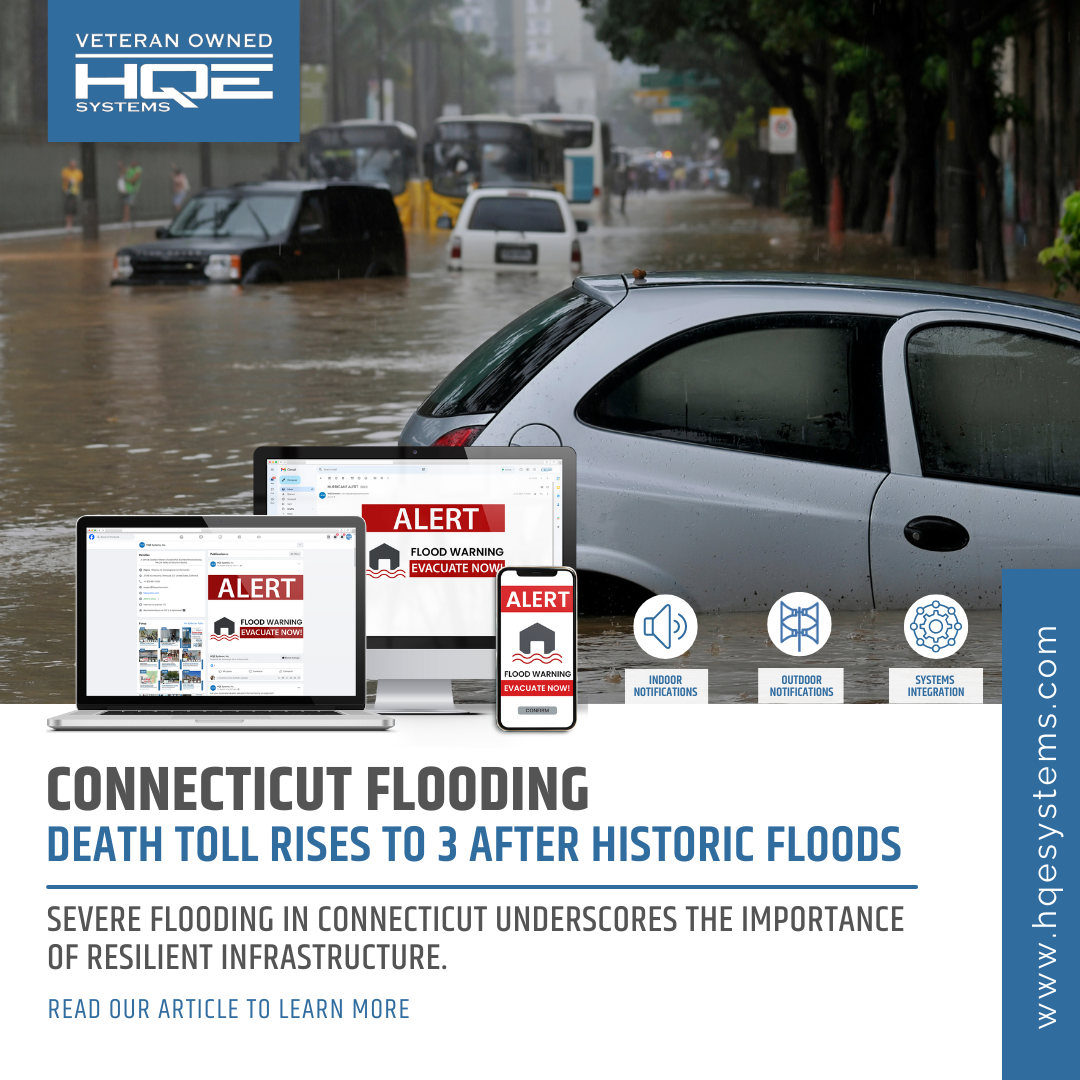The Devastating Connecticut Floods: A Closer Look and How Technology Can Mitigate Future Disasters
In late August 2024, a series of intense storms brought unprecedented rainfall to Connecticut, resulting in widespread flooding that ravaged several communities, particularly in Fairfield, Westport, and Weston. This catastrophic event has once again highlighted the vulnerability of infrastructure and emergency response systems in the face of extreme weather events. As climate change continues to increase the frequency and severity of such disasters, there is an urgent need to rethink and upgrade our emergency management strategies to better protect lives and property.
The Connecticut Floods: An Overview
A Storm Like No Other
Heavy rains swept through Connecticut, causing rivers to overflow and streets to become impassable. The towns of Fairfield, Westport, and Weston were among the hardest hit, with floodwaters rising rapidly, trapping residents in their homes and vehicles. Emergency services were stretched to their limits as they responded to countless calls for help, often hindered by the very conditions they were trying to mitigate (Fox Weather).
The National Weather Service reported that some areas received over seven inches of rain in just a few hours, far exceeding the amount that local drainage systems could handle. The result was catastrophic flooding that left a trail of destruction across the region. Homes were inundated, roads were washed away, and power outages left thousands in the dark, further complicating rescue efforts (AP News).
reported that some areas received over seven inches of rain in just a few hours, far exceeding the amount that local drainage systems could handle. The result was catastrophic flooding that left a trail of destruction across the region. Homes were inundated, roads were washed away, and power outages left thousands in the dark, further complicating rescue efforts (AP News).
The magnitude of the storm brought back memories of past extreme weather events, highlighting the continuous challenges posed by such natural disasters. For the residents of Connecticut, this storm was a stark reminder of the growing need for robust infrastructure that can withstand these increasingly frequent events. It’s not just about responding to disasters after they occur; it’s about preparing communities to handle the worst, minimizing damage, and saving lives.
The Human Toll
Tragically, the floods claimed several lives. In Fairfield County, one man was found dead after being swept away by the floodwaters while trying to escape his submerged vehicle (Fox Weather). The loss of life and the displacement of residents underscore the need for more resilient infrastructure and more effective emergency response systems.
Emergency responders worked tirelessly to rescue those trapped by the rising waters, but their efforts were often hampered by the sheer scale of the disaster. The floods overwhelmed local resources, highlighting the need for better preparation and more robust systems to deal with such extreme weather events (AP News).
The psychological impact on the community has been profound. Many residents are grappling with the trauma of the event, with some expressing fears about the long-term safety of their homes and neighborhoods. For these individuals, the floods are not just a natural disaster but a life-altering event that has left scars that may take years to heal. This human toll, both physical and emotional, underscores the urgent need for communities to be better equipped to handle such crises.
The Impact on Infrastructure
The floods caused significant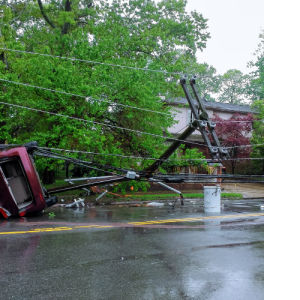 damage to Connecticut’s infrastructure. Roads and bridges were washed out, isolating communities and making it difficult for emergency services to reach those in need. In Westport, several major roads were completely submerged, cutting off access to entire neighborhoods. The town’s sewer systems were overwhelmed, leading to widespread contamination and posing a serious public health risk (AP News).
damage to Connecticut’s infrastructure. Roads and bridges were washed out, isolating communities and making it difficult for emergency services to reach those in need. In Westport, several major roads were completely submerged, cutting off access to entire neighborhoods. The town’s sewer systems were overwhelmed, leading to widespread contamination and posing a serious public health risk (AP News).
The damage to infrastructure was not limited to roads and bridges. Power lines were downed by falling trees, leaving thousands without electricity for days. The disruption of utilities further complicated the response to the disaster, as communication networks were also affected, making it difficult for emergency services to coordinate their efforts.
Beyond the immediate physical damage, the floods exposed vulnerabilities in the region’s critical infrastructure. Aging systems, which have not been adequately maintained or upgraded, failed under the pressure of the storm. This situation not only disrupted lives and businesses but also highlighted the need for significant investment in infrastructure improvements. The inability to quickly restore services such as electricity and clean water further emphasizes the importance of having resilient systems in place before disasters strike.
Economic and Environmental Consequences
The economic impact of the floods is still being assessed, but early estimates suggest that the cost of repairs and recovery will run into the hundreds of millions of dollars. Businesses in the affected areas have been devastated, with many facing an uncertain future. The flooding also caused significant environmental damage, with contaminated floodwaters polluting rivers and wetlands, threatening wildlife and ecosystems.
The long-term economic repercussions could be even more severe, affecting property values, tourism, and the overall economic stability of the region. Small businesses, which are the backbone of many local economies, may find it difficult to recover without significant support. Moreover, the environmental damage caused by the floods could take years to fully reverse, with consequences that could impact the region’s biodiversity and natural resources.
The flooding incident has also brought to light the need for more sustainable and environmentally friendly infrastructure that can better withstand natural disasters while minimizing ecological damage. Investing in such infrastructure not only helps in immediate disaster response but also ensures that future generations inherit a world that is resilient and sustainable.
Transitioning to Technological Solutions: How HQE Systems Can Help
The Importance of Preparedness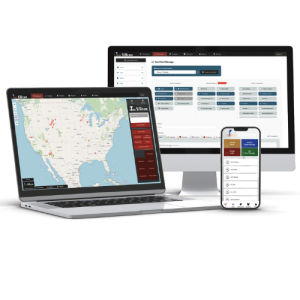
The Connecticut floods serve as a stark reminder of the importance of preparedness in the face of natural disasters. While it’s impossible to prevent such events, their impact can be significantly reduced through better planning, more resilient infrastructure, and advanced emergency management technologies. This is where HQE Systems comes in.
HQE Systems specializes in providing advanced technological solutions designed to enhance the resilience of communities and infrastructure in the face of disasters. By integrating state-of-the-art technologies such as AI, machine learning, and robust communication systems, HQE Systems offers comprehensive solutions that can help mitigate the impact of future floods and other natural disasters.
The concept of preparedness goes beyond just having a plan; it involves equipping communities with the tools they need to respond effectively and efficiently when disaster strikes. HQE Systems offers a range of services and products that ensure communities are not only prepared for disasters but are also capable of responding in a way that minimizes damage and saves lives.
Enhanced Early Warning Systems
One of the key lessons from the Connecticut floods is the need for more effective early warning systems. In many cases, residents were caught off guard by the rapid rise of floodwaters, leaving them little time to evacuate or take protective measures. HQE Systems offers advanced mass notification systems that use AI and machine learning to analyze weather patterns and predict the likelihood of flooding. These systems can provide timely alerts to residents and emergency services, giving them the critical time they need to respond.
HQE’s systems can integrate with local infrastructure to monitor water levels in real-time and send out automated alerts via multiple channels, including SMS, email, and social media. This multi-channel approach ensures that warnings reach as many people as possible, reducing the risk of loss of life and property.
Furthermore, the integration of AI and machine learning allows these systems to continuously learn and improve, making future predictions even more accurate. By combining real-time data with predictive analytics, HQE’s early warning systems provide communities with a vital tool in their disaster preparedness arsenal. This technology not only helps in responding to immediate threats but also plays a crucial role in long-term disaster risk reduction.
Robust Communication Networks 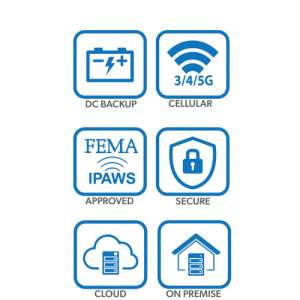
The floods in Connecticut also highlighted the vulnerabilities in communication networks during disasters. Power outages and infrastructure damage can severely disrupt communication, making it difficult for emergency services to coordinate their response. HQE Systems provides robust emergency communication solutions that are designed to remain operational even in the most challenging conditions.
HQE’s emergency communication systems are equipped with backup power sources and can operate independently of the main power grid. This ensures that critical communication lines remain open, allowing emergency services to coordinate their efforts effectively. Additionally, HQE’s systems support multilingual communication, ensuring that all members of the community, regardless of language, receive the information they need.
Effective communication is at the heart of any successful emergency response. HQE’s solutions are designed to overcome the challenges posed by disasters, ensuring that vital information is communicated clearly and quickly. This capability is particularly important in diverse communities where language barriers can hinder effective communication during a crisis.
Infrastructure Monitoring and Management
Another key area where HQE Systems can make a significant impact is in infrastructure monitoring and management. The floods caused widespread damage to roads, bridges, and utilities, much of which could have been mitigated with better monitoring and maintenance.
HQE offers advanced infrastructure monitoring systems that use AI and IoT (Internet of Things) devices to continuously monitor the condition of critical infrastructure. These systems can detect early signs of wear and damage, allowing for proactive maintenance and repairs before a disaster strikes. By keeping infrastructure in good condition, the risk of catastrophic failure during a flood is significantly reduced.
This proactive approach to infrastructure management not only helps to prevent disasters but also extends the lifespan of critical assets, reducing the need for costly repairs and replacements. By investing in HQE’s infrastructure monitoring solutions, municipalities and organizations can ensure that their infrastructure is resilient, reliable, and ready to withstand the challenges posed by natural disasters.
Integrated Emergency Management Systems 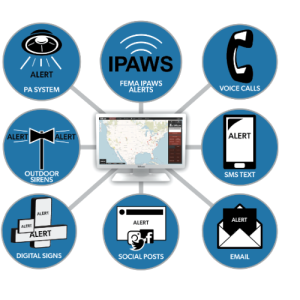
During the Connecticut floods, the sheer scale of the disaster overwhelmed local emergency management systems. HQE Systems provides integrated emergency management solutions that streamline and enhance the coordination of disaster response efforts. These systems bring together all aspects of emergency management—such as resource allocation, communication, and logistics—into a single, user-friendly platform.
HQE’s systems are designed to be scalable and adaptable, making them suitable for use in both small communities and large metropolitan areas. By providing a clear overview of the situation in real-time, these systems enable emergency managers to make informed decisions quickly and effectively, improving the overall response to disasters.
The ability to manage multiple aspects of a disaster response from a centralized platform significantly enhances the efficiency and effectiveness of emergency management efforts. HQE’s solutions are designed to empower emergency managers, providing them with the tools they need to coordinate complex operations and make decisions that save lives.
Looking Ahead: Building Resilience for the Future
Community Engagement and Education
In addition to providing advanced technological solutions, HQE Systems is committed to engaging with communities and educating them on the importance of disaster preparedness. By working closely with local governments, businesses, and residents, HQE helps to foster a culture of resilience, ensuring that everyone is equipped with the knowledge and tools they need to respond effectively to disasters.
This includes training programs on how to use emergency management systems, as well as public awareness campaigns on the importance of preparedness. By empowering communities with the right information and resources, HQE helps to reduce the vulnerability of populations to natural disasters.
Education is a critical component of resilience. HQE’s approach to community engagement goes beyond simply providing technology; it involves working with communities to build their capacity to respond to disasters. This holistic approach ensures that communities are not only better prepared for disasters but are also more resilient in the face of future challenges.
Sustainability and Environmental Stewardship
Building resilience is not just about preparing for disasters; it’s also about addressing the root causes of vulnerability. HQE Systems is committed to sustainability and environmental stewardship, recognizing that protecting the environment is a key component of disaster risk reduction.
about preparing for disasters; it’s also about addressing the root causes of vulnerability. HQE Systems is committed to sustainability and environmental stewardship, recognizing that protecting the environment is a key component of disaster risk reduction.
HQE’s solutions are designed with sustainability in mind, from using energy-efficient technologies to reducing the environmental impact of infrastructure projects. By promoting sustainable practices and supporting efforts to mitigate climate change, HQE contributes to the long-term resilience of communities.
Sustainability and resilience go hand in hand. By investing in sustainable infrastructure and practices, communities can reduce their vulnerability to disasters while also contributing to the broader goal of environmental protection. HQE’s commitment to sustainability ensures that its solutions are not only effective in the short term but also beneficial for future generations.
Collaboration and Innovation
Finally, HQE Systems recognizes that building resilience requires collaboration and innovation. No single entity can address the challenges posed by natural disasters alone. HQE is committed to working with a wide range of stakeholders—including government agencies, private sector partners, and non-profit organizations—to develop and implement innovative solutions that enhance disaster preparedness and response.
Through partnerships and collaboration, HQE continues to push the boundaries of what is possible, using the latest technologies and best practices to protect communities from the devastating impacts of natural disasters.
Innovation is at the core of HQE’s approach to disaster resilience. By staying at the forefront of technological advancements and working closely with partners across sectors, HQE is able to deliver solutions that are not only cutting-edge but also practical and effective. This commitment to innovation ensures that HQE’s solutions remain relevant and impactful in an ever-changing world.
Path to Recovery: Strengthening Infrastructure for Tomorrow’s Challenges
The recent floods in Connecticut have once again highlighted the need for improved disaster preparedness and resilience. While the damage has been extensive, it also presents an opportunity to rethink and improve our approach to emergency management. By investing in advanced technologies and adopting a proactive stance, we can mitigate the impact of future disasters and protect our communities.
have once again highlighted the need for improved disaster preparedness and resilience. While the damage has been extensive, it also presents an opportunity to rethink and improve our approach to emergency management. By investing in advanced technologies and adopting a proactive stance, we can mitigate the impact of future disasters and protect our communities.
HQE Systems stands ready to help communities build a more resilient future. With our advanced technological solutions, we offer the tools and expertise needed to enhance emergency preparedness and response. As we look ahead, it is clear that resilience is not just an option; it is a necessity. Let us work together to build safer, stronger communities that are ready to face whatever challenges lie ahead.
HQE Systems is a certified Veteran Owned Company. For more information about HQE Systems Inc. and its emergency management, electronic security, and integration solutions, please visit www.hqesystems.com.

Contact: David Ditto (Early Warning Systems Subject Matter Expert)
Email: David.Ditto@hqesystems.com
Phone Number: (843) 872-7020
____________________
HQE Systems, Inc. | HQE is a Minority-Owned Service Disabled Veteran Owned Small Business (SDVOSB) providing full solutions for: Mass Notification Systems, Electronic Security Systems, Software Development Services, Contract Support, and Prototyping Services. As a brand-agnostic solutions provider, HQE prides itself in providing the BEST solution for the project. HQE possesses over 30+ factory certifications and reseller licenses to ensure our clients receive the highest quality service at the ideal budget. HQE can provide full design, installation, integrations, upgrades, and long-term maintenance support for any size and scope project.

